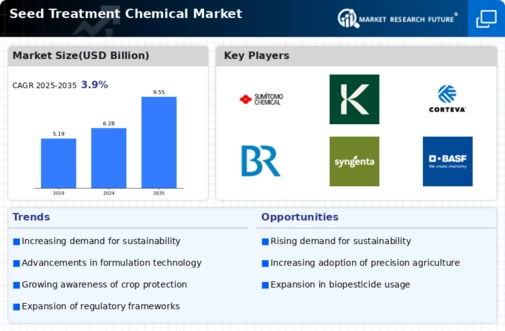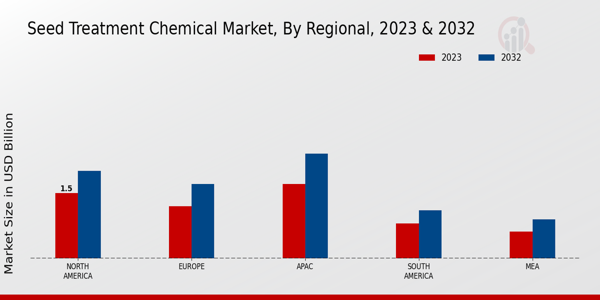Market Growth Projections
The Global Seed Treatment Chemical Market Industry is poised for substantial growth, with projections indicating a market value of 9.55 USD Billion by 2035. This growth trajectory is underpinned by a compound annual growth rate of 3.88% from 2025 to 2035, reflecting the increasing adoption of seed treatment technologies across various regions. The market dynamics are influenced by factors such as rising agricultural investments, technological advancements, and changing consumer preferences towards sustainable practices. As the industry evolves, stakeholders are likely to witness significant opportunities for innovation and expansion.
Increasing Demand for High-Quality Seeds
The Global Seed Treatment Chemical Market Industry experiences a surge in demand for high-quality seeds, driven by the need for improved crop yields and disease resistance. Farmers increasingly recognize that seed treatment enhances seed performance, leading to better germination rates and healthier plants. This trend is particularly evident in regions where agricultural productivity is paramount. As a result, the market is projected to reach 6.28 USD Billion in 2024, reflecting the growing investment in seed treatment technologies. The emphasis on quality seeds aligns with global food security goals, further propelling the market forward.
Rising Global Population and Food Demand
The escalating global population and the corresponding increase in food demand are critical drivers of the Global Seed Treatment Chemical Market Industry. As the world population approaches 9.7 billion by 2050, the pressure on agricultural systems intensifies. Seed treatments are essential for maximizing crop yields and ensuring food security in this context. Farmers are compelled to adopt advanced seed treatment solutions to meet the growing demand for food. This trend is expected to sustain market growth, with projections indicating a market value of 6.28 USD Billion in 2024, as stakeholders seek effective solutions to address food scarcity.
Growing Awareness of Sustainable Agriculture
There is a notable shift towards sustainable agricultural practices, significantly influencing the Global Seed Treatment Chemical Market Industry. Farmers are increasingly adopting eco-friendly seed treatments to minimize environmental impact while maximizing crop productivity. This trend aligns with global initiatives aimed at promoting sustainable farming methods. The rising awareness of the benefits of integrated pest management and organic farming practices further drives the demand for seed treatments that are less harmful to ecosystems. As sustainability becomes a priority, the market is likely to witness a compound annual growth rate of 3.88% from 2025 to 2035, reflecting the industry's adaptation to these changing preferences.
Technological Advancements in Seed Treatment
Technological innovations play a pivotal role in shaping the Global Seed Treatment Chemical Market Industry. The development of advanced seed treatment formulations, including biological and chemical agents, enhances the efficacy of treatments against pests and diseases. These innovations not only improve seed health but also contribute to sustainable agricultural practices. For instance, the introduction of nano-technology in seed treatments has shown promising results in enhancing nutrient uptake. As the market evolves, these advancements are expected to drive growth, with projections indicating a market value of 9.55 USD Billion by 2035, highlighting the potential for continued innovation.
Regulatory Support for Seed Treatment Chemicals
Regulatory frameworks supporting the use of seed treatment chemicals significantly impact the Global Seed Treatment Chemical Market Industry. Governments worldwide are increasingly recognizing the importance of seed treatments in enhancing agricultural productivity and food security. Initiatives aimed at streamlining the approval process for new seed treatment products encourage innovation and market entry. For instance, regulatory bodies are focusing on the safety and efficacy of seed treatments, ensuring that they meet environmental and health standards. This supportive regulatory environment is likely to foster growth in the market, facilitating the introduction of new products and technologies.




















